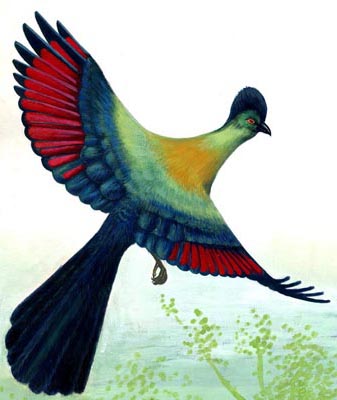The ENTC now has a new website, at www.entc.org.sz
Our logo is adapted from a painting by Phillip Dlamini, 1998, of a purple crested turaco. In traditional Swazi dress, the red feathers feature in the royal headdress, so this bird illustration is not only a symbol for wildlife conservation, but also of cultural heritage.


In 1902, a victorious Britain declared Swaziland as "protectorate" under a Resident Commissioner, reporting to a High Commissioner in Pretoria. The British applied their usual policy of indirect rule, leaving the monarchy and chieftaincy basically intact. The British listed the chiefs and their "indunas" (lieutenants) in order to tax all adult males. Migrant labour had had a late start in Swaziland, in the 1890s, now it increased as men needed to pay tax.
In 1907, the British partitioned the land giving two thirds to white sellers and one third to the Swazis under their chiefs. Sobhuza's grandmother, the Queen Regent Labotsibefli, was a formidable opponent of the British rulers. She sent Sobhuza to Lovedale School in the Cape.
Sobhuza was installed in 1921. To the British he was "Paramount Chief while to the Swazis he was king. In effect he was the head of the Swazi Nation for 47 years prior to independence.
(For more detailed information on Sobhuza - see History of King Sobhuza II.)
In 1923 Sobhuza went to England to challenge the land partition but lost the case.
In 1941, the British requested help for the war effort, and Sobhuza approved the joining up of about 4,000 Swazi men who served in North Africa and Italy.
After World War II, the economy was boosted, mostly by the first pine and sugar plantations.
In the early 1960s, as other African colonies regained their independence, Britain encouraged the formation of political parties. Sobhuza formed the "imbokodvo" ("grindstone") National Movement. The movement won all the seats in the first elections in 1967.
Swaziland regained its independence on 6 September 1968. It was the only state in Africa ruled by the natural successors of the leadership of pre-colonial times.
In the second elections in 1973, the rival "Congress" party won three of the 18 seats. Sobhuza-in- Council then dissolved Parliament, repealed the Constitution and ruled by decree until 1978, when elections were held under the "Tinkhundla" (constituency) system. King Sobhuza II then ruled as Africa's executive monarch until his death in 1982.
A supreme council of state ("Liqoqo") ruled the country for four years, while the Crown Prince, Makhosetive, finished high school in England. (Sherborne School, Dorset). Makhosetive became King Mswati III in 1986.
Our Contacts:
Head Quarters: (+268) 2416 1489/1179
Email: info@sntc.org.sz
King Sobhuza II Park: (+268) 2416 1489/1179
Email: ksmp@sntc.org.sz
National Museum: (+268) 2416 1489/1179
Email: curator@sntc.org.sz
Copyright © ESWATINI NATIONAL TRUST COMMISSION
Malolotja Nature Reserve: (+268) 2444 3241 / (+268) 2416 1480
Email: culturalvillage@sntc.org.sz
Mantenga Nature Reserve and Swati Cultural Village: 2416 1151/1178
Email: culturalvillage@sntc.org.sz
Mlawula Nature Reserve: (+268) 2383 8885 (Reception)
(+268) 2383 8453 (Senior Warden)
Email: culturalvillage@sntc.org.sz
Magadzavane Lodge: (+268) 2343 5108/9
Email: magadzavane@sntc.org.sz